Imagine a family adventure where your children can explore misty rainforests, build sandcastles on rugged beaches, and marvel at snow-capped mountains, all in one trip. The Olympic Peninsula Loop brings together all these incredible experiences, giving your family an adventure everyone will enjoy. Along the way, you’ll discover the diverse landscapes of Olympic National Park, explore quirky small towns, and find plenty of kid-friendly stops that make the miles fly by.
Based on our firsthand experiences traveling this spectacular route, we’ve consolidated this comprehensive guide to help you navigate this 330-mile journey with your kids. The peninsula’s diverse ecosystems, from stunning coastlines to ancient forests, offer a fun-filled vacation with plenty of opportunities to incorporate education along the way.
The Olympic Peninsula is a treasure trove of stunning landscapes, featuring 49 peaks that soar over 6,500 feet, over 600 miles of trails for exploration, breathtaking glaciers, and four temperate rainforests. Ready to go? This itinerary breaks down the journey into manageable sections for families with minimal backtracking.
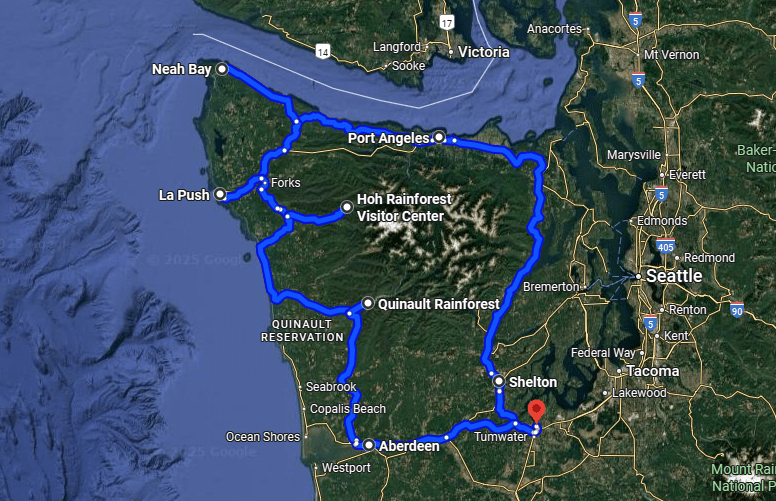
Getting to Know the Olympic Peninsula Loop
The Olympic Peninsula loop encompasses approximately 329.2 miles of breathtaking scenery circling Olympic National Park.
We suggest starting in Olympia and traveling counter-clockwise; it’s a great way to enjoy a gradual build-up of exciting experiences along the way and enjoy the scenery without looking across traffic. We’ve divided the loop into five distinct sections.
- Olympia to Port Townsend (106 miles, 2 hours drive time)
- Port Townsend to Port Angeles (48 miles, 1 hour drive time)
- Port Angeles to Neah Bay to Forks (120 miles, 3 hours drive time)
- Forks to beaches to Aberdeen (124 miles, 2.5 hours drive time)
- Aberdeen to Kamilche (52 miles, 1 hour drive time)
You can adjust the sections according to your travel pace and family’s interests and energy levels.
Highway 101 serves as the primary artery for most of the journey, making navigation easy. The road conditions range from smooth highways to some winding sections, but they’re all easily navigable with a standard family vehicle.
- Getting to Know the Olympic Peninsula Loop
- Section 1: Olympia to Port Townsend
- Section 2: Port Townsend to Port Angeles
- Section 3: Port Angeles to Neah Bay to Forks
- Section 4: Forks to Beaches to Aberdeen
- Section 5: Aberdeen to Kamilche/Olympia
- 8-Day Olympic Peninsula Itinerary with Kids
- 10 Essential Tips for Families Traveling the Olympic Peninsula
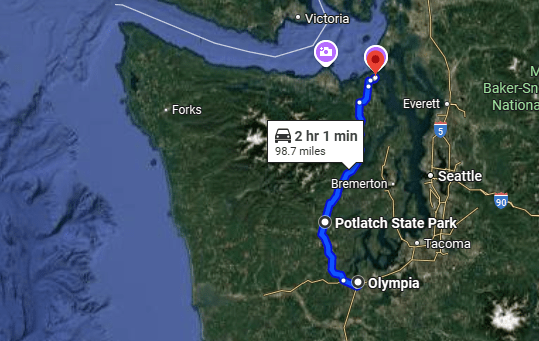
Section 1: Olympia to Port Townsend
Starting in Olympia
While some maps skip over Olympia when outlining the Olympic Peninsula loop, we have included it. As Washington’s capital, Olympia holds its own charm, less flashy than Seattle, but full of history, nature, and local character. Plus, Olympia/Tumwater is where Highway 101 officially begins, making it a natural starting point for families beginning their loop adventure.
You’ll find Olympia is a great place to ease into road trip mode. Add spacious parks, interactive museums, and spots to run, snack, and stretch to your itinerary. Here are six kid-friendly highlights to explore before hitting the road:
- Hands On Children’s Museum: One of the best children’s museums in the state, plan to spend a few hours here.
- Capitol Campus: The Capitol Campus offers several tours, including Legislative Building Tours, Governor’s Mansion Tours, Memorial Tours, and Botanical Tours, each designed to explore different aspects of its history, architecture, and natural beauty.
- Heritage Park Fountain: Open seasonally for splashing and cooling off with views of Capitol Lake.
- Percival Landing Park: A downtown boardwalk with views of the marina and space for a family picnic.
- Olympic Flight Museum (Tumwater): Established in 1998 at the Olympia Regional Airport in Washington, this small museum allows the exploration of vintage aircraft and aviation history.
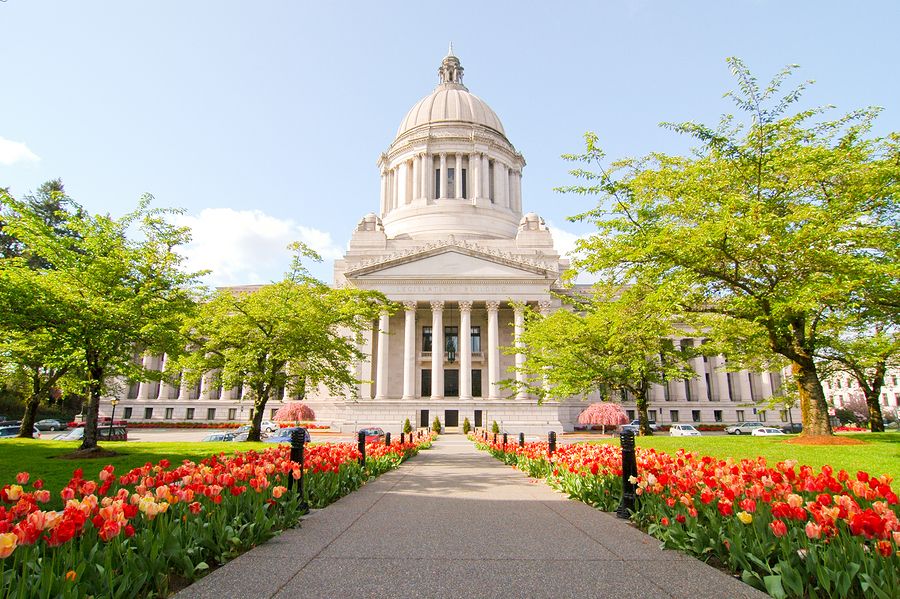
What to See Along the Route (Olympia to Port Townsend)
The 106-mile drive from Olympia to Port Townsend follows Highway 101 through forested valleys, inlets, and small towns that invite you to slow down and explore. This section isn’t just a transition; there are plenty of opportunities to add great stops to your family’s itinerary.
- Shelton – 25 miles from Olympia (Mile Marker ~339)
Shelton is one of Washington’s oldest logging towns and a great place to stretch your legs early in the trip. Known for its forestry heritage, the town proudly displays a 25-foot Paul Bunyan and Babe the Blue Ox, perfect for a quirky family photo. Depending on the time of year, Paul and Babe may be relocated around town. There’s also a logging history mural downtown that adds color and context to the area’s timber legacy. - High Steel Bridge – ~14 miles northwest of Shelton (via Forest Service Road 2340)
Although it requires a detour from 101, this engineering marvel is well worth it. The bridge soars 375 feet above the Skokomish River, offering breathtaking canyon views; just be sure to keep little ones close, as there are no railings. It’s one of the tallest railroad bridges in the U.S. and a hidden gem for adventurous families. - Potlatch State Park – 33 miles from Olympia
Just a few miles north of Lilliwaup, Potlatch is a favorite for families. It offers easy beach access, a playground, picnic shelters, and tidal exploration, plus restrooms and flat walking paths. If you’re lucky, you may even catch tribal fishing boats in action just offshore. - Lake Cushman Lookout – Just before Staircase entrance on Lake Cushman Road
This pull-off provides stunning views of Lake Cushman backed by jagged peaks — an ideal picnic or photo stop. The overlook gives families a chance to appreciate the scale and serenity of the Olympic foothills. - Staircase Entrance, Olympic National Park – ~42 miles from Olympia (via Lake Cushman Road)
Located near Lake Cushman, the Staircase entrance offers a peaceful first taste of Olympic National Park. Families love the 2-mile Staircase Rapids Loop Trail, which winds through mossy forest alongside the Skokomish River. It’s a great way to introduce kids to the park’s rainforest landscape without major elevation gain. - Lilliwaup Tidelands State Park – 47 miles from Olympia
Right off Highway 101, this peaceful marine area lets kids explore the shoreline and spot shellfish at low tide. It’s a quieter alternative to busier parks and a great place to stop for beach play or nature observation. Parking is easy and the access is flat. - Fall View Canyon Trail – ~70 miles from Olympia
This lesser-known trail offers a short forested hike with mossy canyon views, located just north of Potlatch. It’s a good pick for older kids who want a bit more of a hike but not a full-day adventure. - Mount Walker Lookout – ~78 miles from Olympia (via Mount Walker Viewpoint Rd)
Just south of Quilcene, this gravel forest road leads to two vehicle-accessible viewpoints with sweeping views of Puget Sound and the Olympic Mountains. It’s one of the few places on the peninsula where you can drive to a panoramic summit. On clear days, you can see all the way to Seattle.
Family-Friendly Accommodations
Since big family hotel options are limited along parts of the route, vacation rentals may be necessary in some areas. While we typically don’t recommend vacation rentals for road trips due to cleaning fees and short stays, they can sometimes be the only option for big families. Start your adventure with a stay in Olympia, then plan your next overnight in Port Townsend or travel a bit farther to Port Angeles.
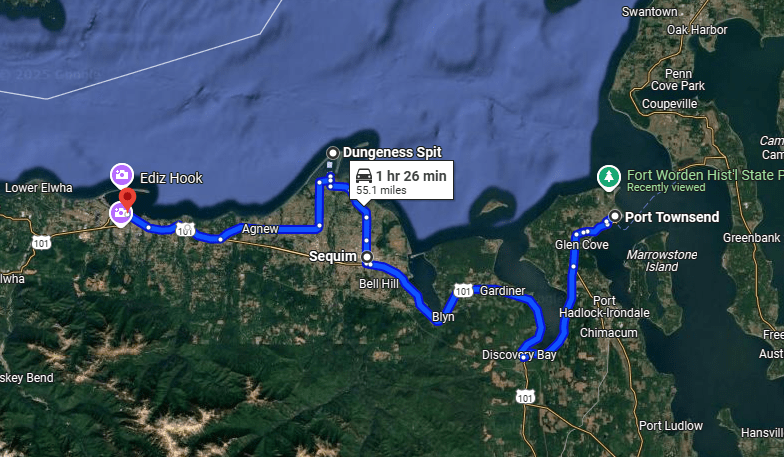
Section 2: Port Townsend to Port Angeles
Exploring Port Townsend
Don’t rush through Port Townsend. This charming Victorian seaport is a perfect overnight stop or full-day destination, with a walkable downtown, maritime history, and hands-on learning opportunities.
- Fort Worden Historical State Park: Kids can roam old military bunkers, climb to the lighthouse, and explore windswept beaches.
- Port Townsend Marine Science Center: Located within the park, this center features touch tanks, interactive exhibits, and marine life education tailored to young learners.
- Downtown Water Street: Walk along the waterfront and explore ice cream parlors, toy shops, and the quirky Clothes Horse, where kids can try on vintage hats and costumes.
- Boat watching at the marina: Let kids spot sailboats and seabirds while you grab a coffee from a local café.
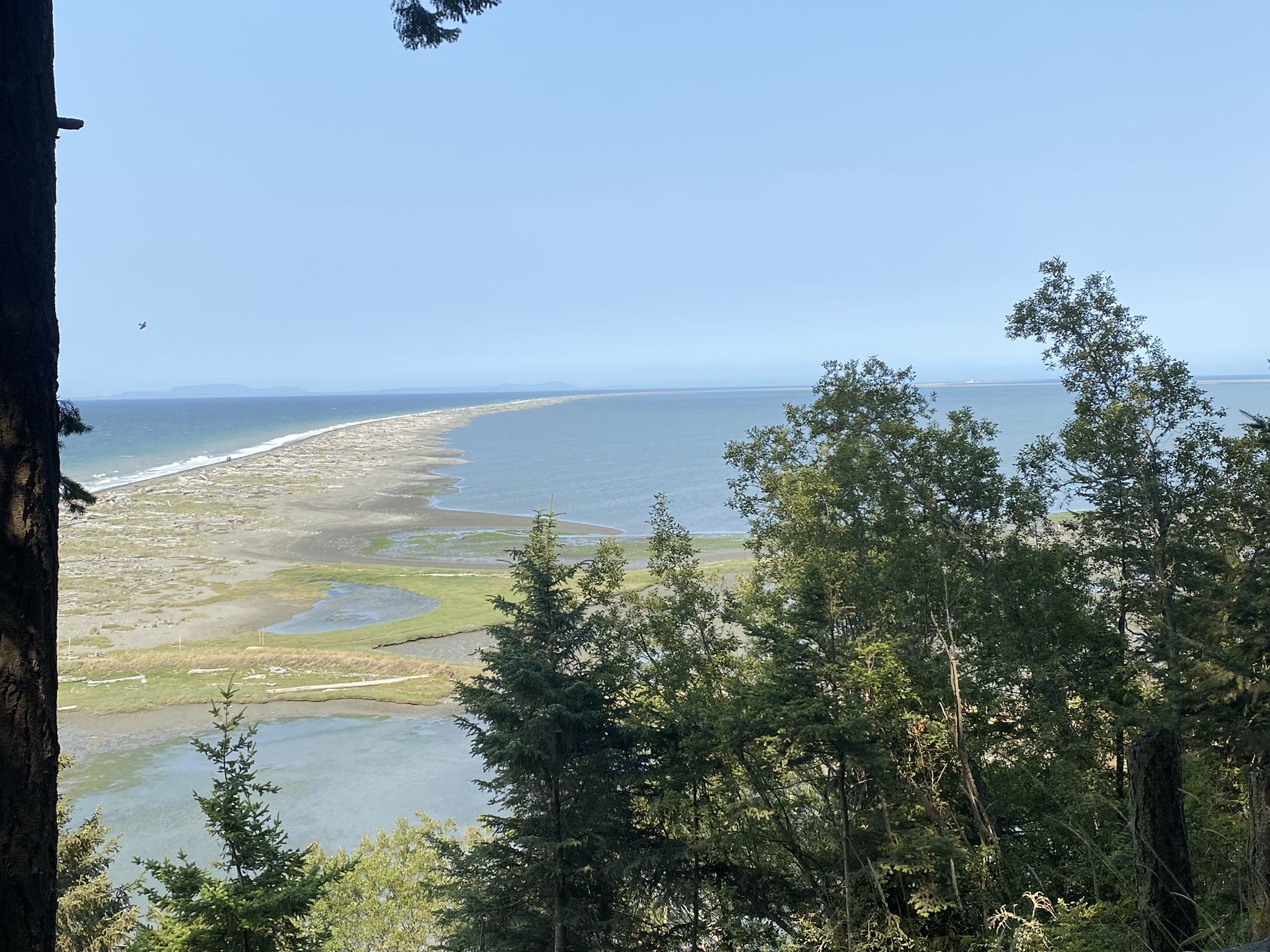
What to See Along the Route (Port Townsend to Port Angeles)
This 48-mile stretch passes through open farmland, rivers, and quiet rural towns before reaching the rugged Olympic foothills. Don’t be fooled by the short drive time, as there’s enough to fill a full day if you want to slow down and explore.
- Chimacum Valley: This agricultural community is known for artisan cheese, cider, and fresh produce. Consider a quick stop at a roadside farm stand or market.
- Sequim: With a sunny microclimate and relaxed pace, Sequim is great for a midday break. In summer, lavender farms like Purple Haze bloom with color and offer family-friendly experiences, including crafts and scavenger hunts. The area hosts a Sequim Lavender Festival each year in July.
- Dungeness Spit: The 5.5-mile-long spit is the longest natural sand spit in the U.S., stretching into the Strait of Juan de Fuca. You don’t have to hike the full length; even a short walk offers driftwood collecting, views of the lighthouse, and seal spotting from the beach. Note: The park has a small $3 per vehicle day-use fee; be sure to bring cash for the payment envelopes.
As you arrive in Port Angeles, you’ll be at the doorstep of some of Olympic National Park’s biggest highlights. So rest up, grab groceries if needed, and get ready for alpine adventures in the next leg of your journey. We found that the local Safeway had everything we needed, along with a selection of grab-and-go meals.
Family-Friendly Accommodations
To fully explore this area, we suggest booking a hotel for a couple of nights in Port Angeles.
Travel Tip: You can join the Olympic Peninsula loop here by taking a vehicle ferry from Seattle to Bainbridge Island, then driving north to Port Townsend. If traveling from Seattle, it’s a scenic and fun way to kick off the road trip with kids. I know we enjoyed our ferry ride, which might seem silly for those who take it often, but it was a new experience for us.
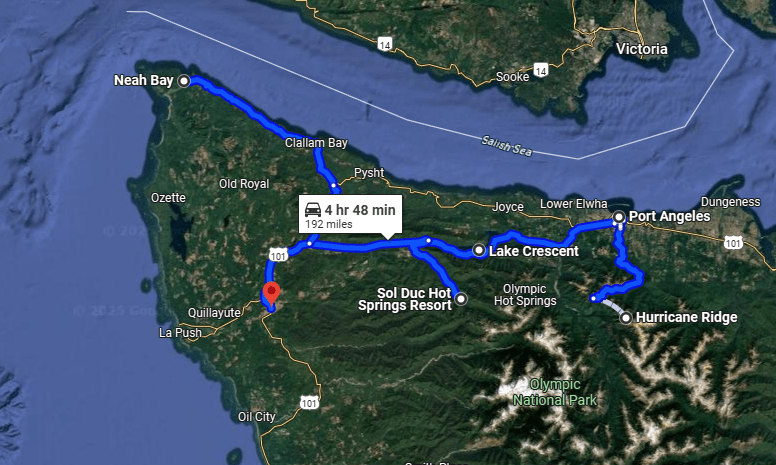
Section 3: Port Angeles to Neah Bay to Forks
This stretch of the Olympic Peninsula could easily fill two to three days and it’s worth every minute. From alpine ridges to glacial lakes, hot springs, and tribal lands, this section includes some of the park’s most iconic landscapes. It’s also one of the most popular areas of the loop. Don’t exclude the city of Port Angeles from your exploration. Walk the downtown and waterfront areas. Check out the visitor center at the Wharf, where you’ll find shops, dining, and an arcade.
Need help deciding where to spend your time? Check out our full Olympic National Park family guide. We cover all 10 regions of the park from Hurricane Ridge to Coastal Beaches and everything in between.
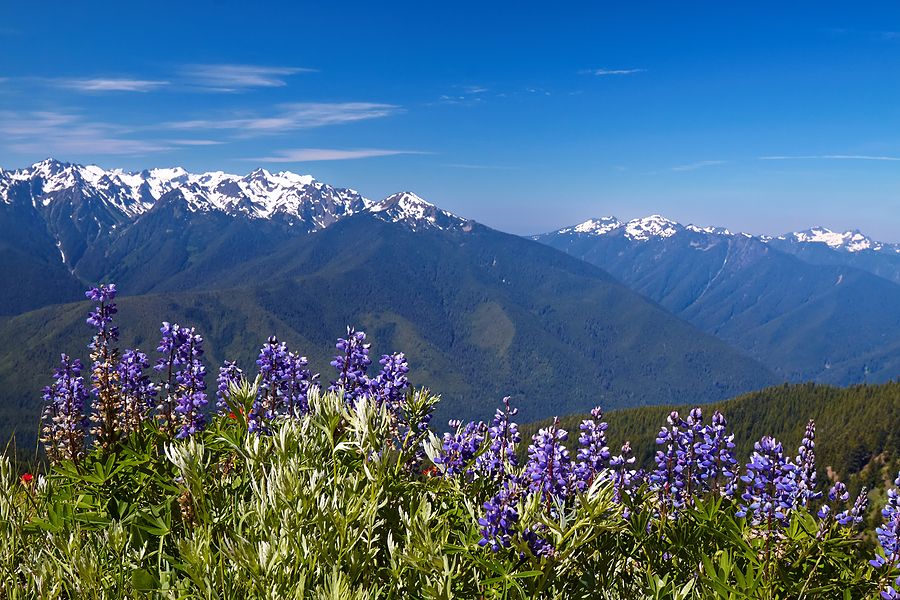
Hurricane Ridge Adventures
Port Angeles serves as the gateway to some of Olympic National Park’s most spectacular attractions. Hurricane Ridge, just 17 miles from downtown, offers families breathtaking alpine views without strenuous hiking. You’ll enjoy views of several prominent mountain peaks, such as Mount Olympus, Mount Angeles, and the Bailey Range. The paved Hurricane Hill Trail (3.2 miles round-trip) has panoramic vistas of the Olympic Mountains and Strait of Juan de Fuca.
The Hurricane Ridge Visitor Center provides junior ranger activities and educational displays about mountain ecosystems. During winter months, the area transforms into a family-friendly ski and snowboard destination with equipment rentals available.
During our visit in July, the large parking lots were only half full. You’ll find benches near the entrance that are great for a snack or lunch break. Note that cloud cover, haze, and any area wildfires will impact your views. During our visit, it was overcast and we recommend two days in the area to increase your chance of clear skies.
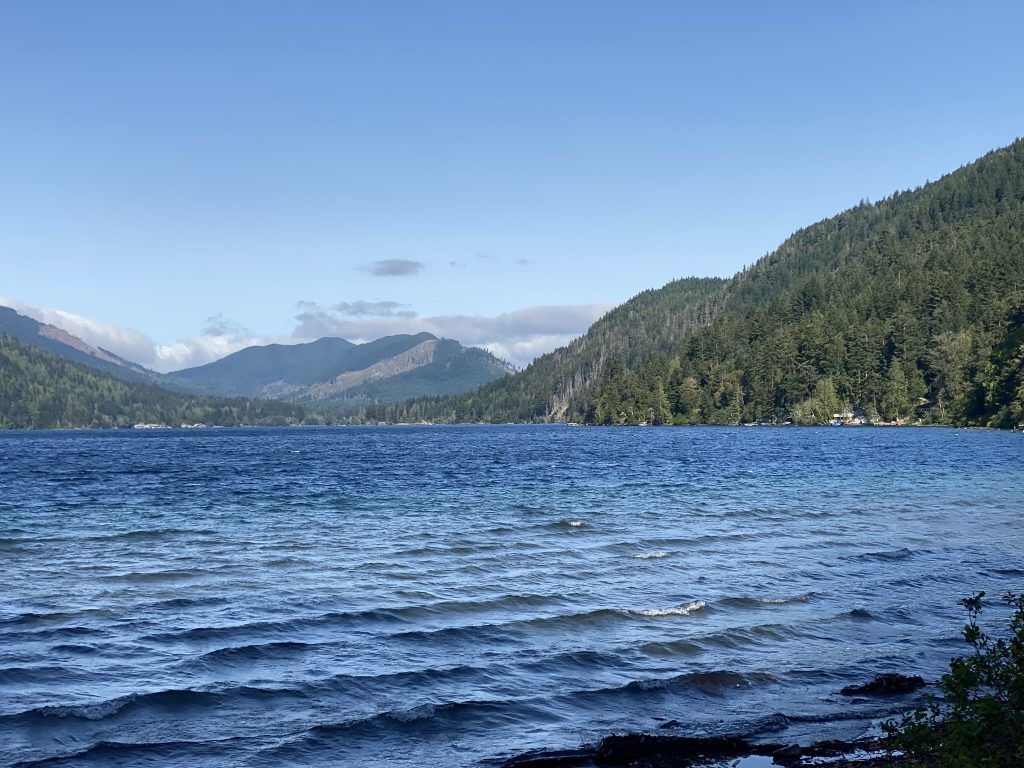
Lake Crescent and Sol Duc
Continuing west, Lake Crescent’s strikingly clear waters are great for swimming, paddling, and picnicking. The lake is glacier-fed, so be prepared for cold water. The historic Lake Crescent Lodge offers kayak and canoe rentals perfect for family outings. The easy Marymere Falls Trail (1.8 miles round-trip) leads through old-growth forest to a 90-foot waterfall..
Nearby Sol Duc Hot Springs Resort provides a unique opportunity for families to soak in mineral-rich pools surrounded by forest. The 1.6-mile trail to Sol Duc Falls is a popular attraction, with the thundering cascade splitting into multiple channels before plunging into a narrow gorge. Parking for the falls is limited; you may have to park quite far away or plan on a longer hike by parking near the visitor center.
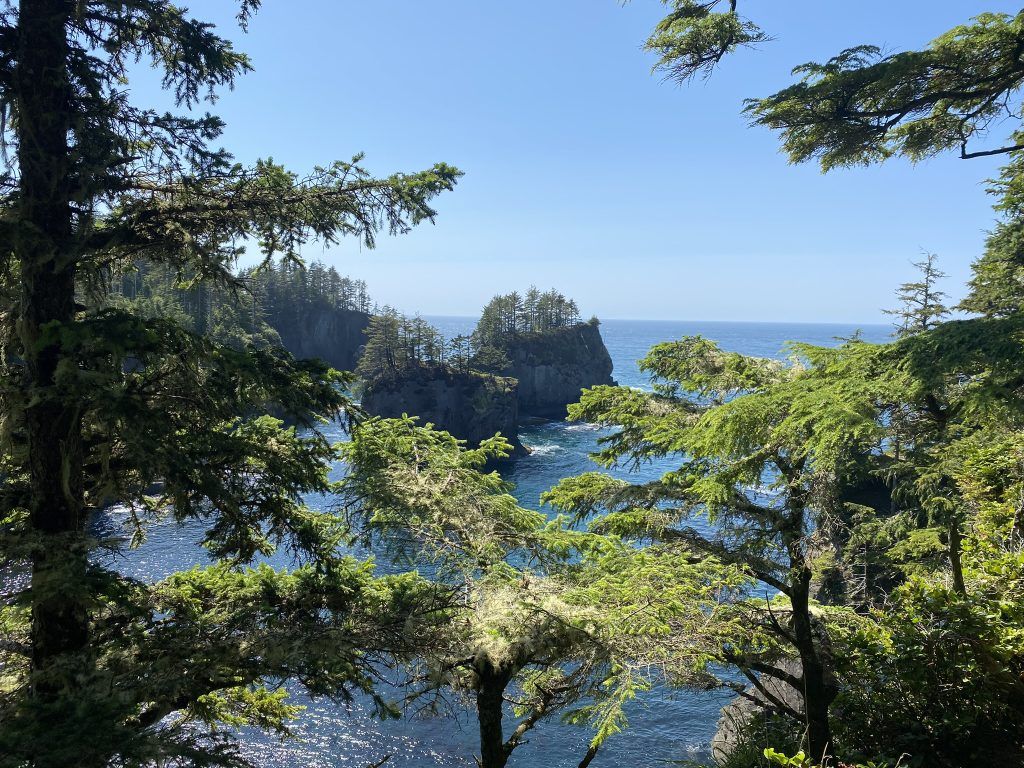
Cape Flattery and Neah Bay
The drive to Neah Bay along State Highway 112 (the Strait of Juan de Fuca Scenic Byway) offers coastal views of sea stacks and the Strait of Juan de Fuca, making it one of the most scenic stretches of the Olympic Peninsula. Upon reaching Neah Bay on Makah tribal lands, you must purchase a Makah Recreation Pass ($20 per vehicle) to access Cape Flattery and Shi Shi Beach.
The Cape Flattery Trail (1.5 miles round-trip) leads to the northwesternmost point of the contiguous United States. Boardwalks and viewing platforms make this accessible for children while protecting sensitive vegetation.
Before leaving Neah Bay, visit the Makah Cultural and Research Center to learn about the tribe’s rich heritage through artifacts and interactive displays.
Option 2: Explore Ozette
Located on the northwestern coast of the Olympic Peninsula, enjoy hiking through the old-growth forests from Lake Ozette to the Pacific Coast. Two trails, Cape Alava and Sandpoint, offer 3-mile walks to the coast along mostly boardwalk trails. At the coast, you can explore tide pools and, during migration seasons, catch a glimpse of seals and gray whales
Family-Friendly Accommodations
End your exploration of section 4 with a hotel in Forks.
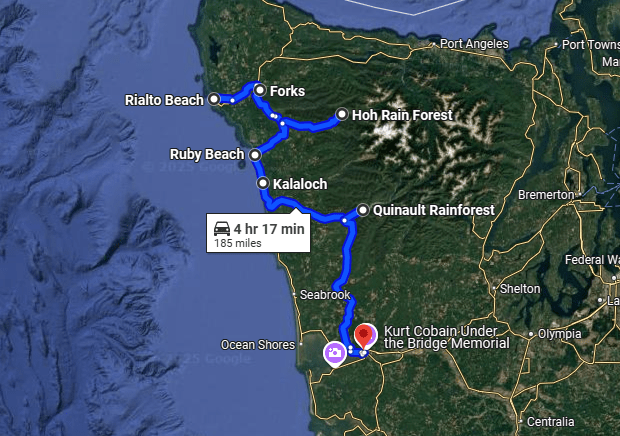
Section 4: Forks to Beaches to Aberdeen
Section 4 of the Olympic Peninsula loop offers some of the most unforgettable natural scenery of the entire route. Towering sea stacks, tidepool-filled beaches, and moss-draped rainforests create a day (or two) packed with ocean fun. If tidepooling is high on your family’s list, consider planning your entire trip around the best low tide window and build your itinerary backward from there.
This stretch of coastline offers several beautiful beaches to choose from, each with different access and terrain. While we enjoyed visiting Rialto, the rocky area around Hole in the Wall can be slick with seaweed, so appropriate footwear is needed. Ruby Beach offers vault toilets and a gravel trail that leads through driftwood to the beach, making access relatively easy. In contrast, Beach #4 requires navigating stairs and a rope-assisted 4-foot drop from a rock outcropping to reach the sand. When we visited, a ranger was stationed at Beach #4 during low tide, answering questions and helping kids spot sea stars and anemones. All three beaches are recommended.
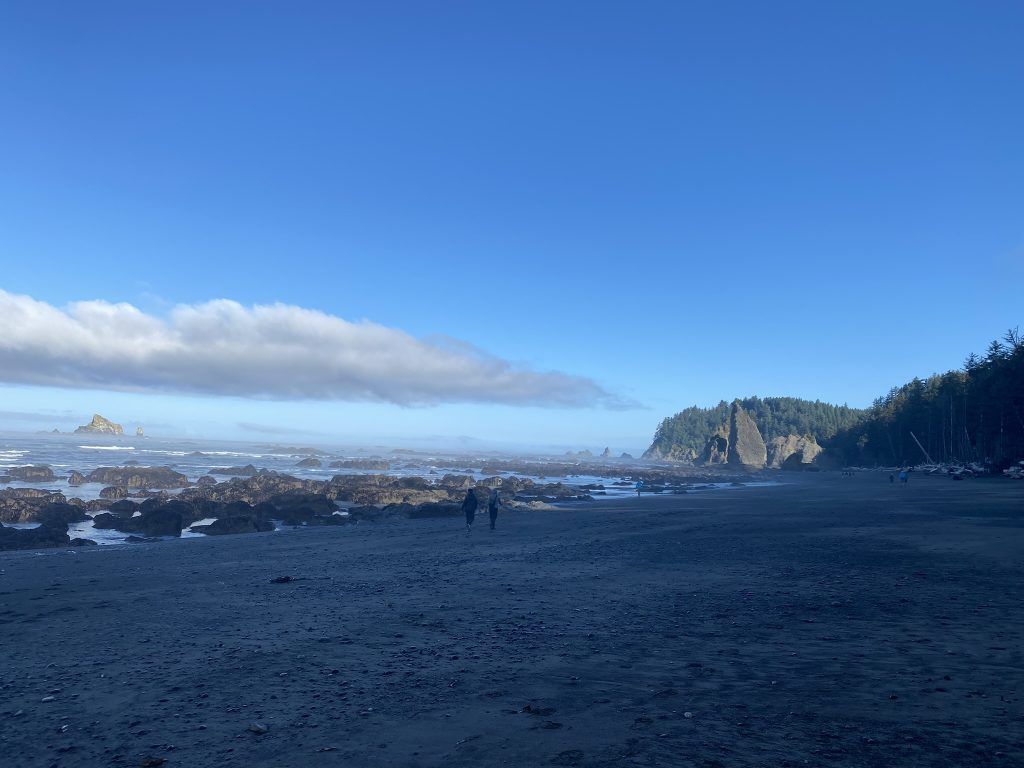
Twilight Town and Pacific Beaches
Forks gained fame as the setting for the Twilight series, and fans can visit locations mentioned in the books. However, the real stars of this section are the magnificent beaches of Olympic National Park’s western coastline.
Rialto Beach offers the perfect introduction to the Pacific shore with its dramatic sea stacks and driftwood. The 1.5-mile walk to Hole-in-the-Wall rewards families with fascinating tide pools during low tide. Here, you’ll discover sea stars, anemones, and tiny crabs in these natural aquariums.
Further south, Ruby Beach captivates with its distinctive rock formations and tide pools. The relatively easy access from the parking area makes it ideal for families with younger children.
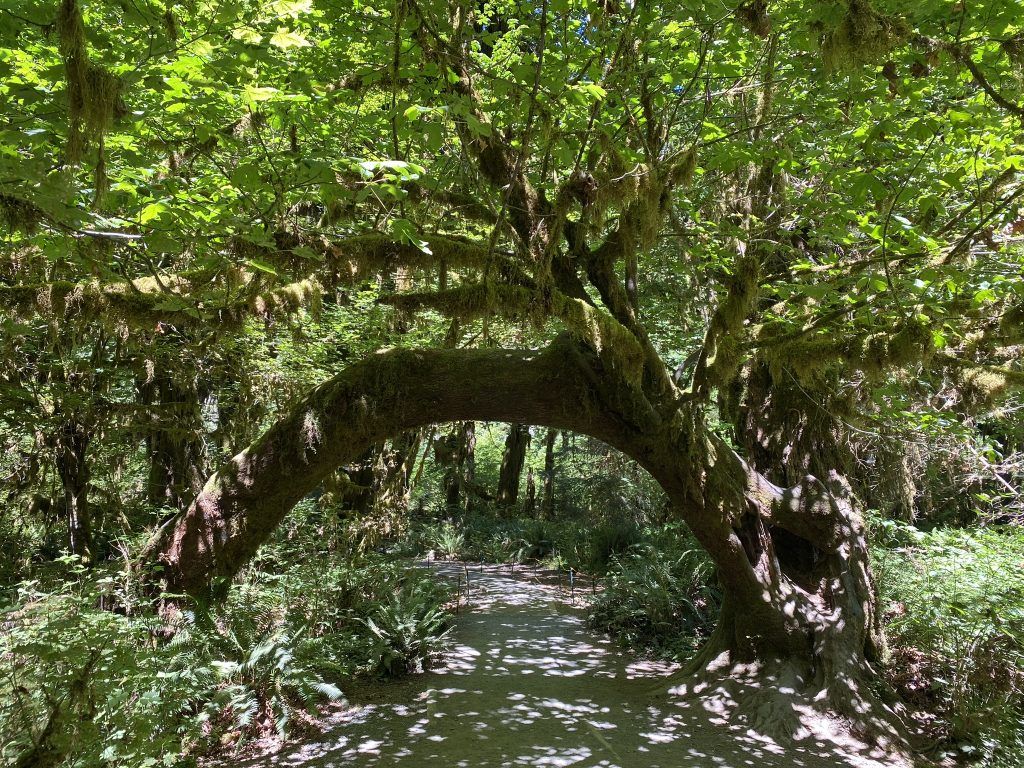
Hoh Rain Forest
No family trip to the Olympic Peninsula is complete without experiencing the Hoh Rain Forest. This green wonderland receives approximately 140 inches of rainfall annually, creating an otherworldly landscape draped in mosses and ferns.
The Hall of Mosses Trail (0.8 miles) and Spruce Nature Trail (1.2 miles) are two of the best ways for families to experience the rainforest’s magic without a long trek. Along the way, placards explain features like nurse logs, hanging moss, and the small creatures that thrive in this lush, damp environment.
Keep in mind, the Hoh Rain Forest is one of the park’s most visited areas. During summer, it’s not uncommon to wait one to two hours to enter the parking area. To avoid long lines and crowded trails, consider arriving before 9 a.m. or after 4 p.m. Alternatively, you can visit on a weekday if your schedule allows.
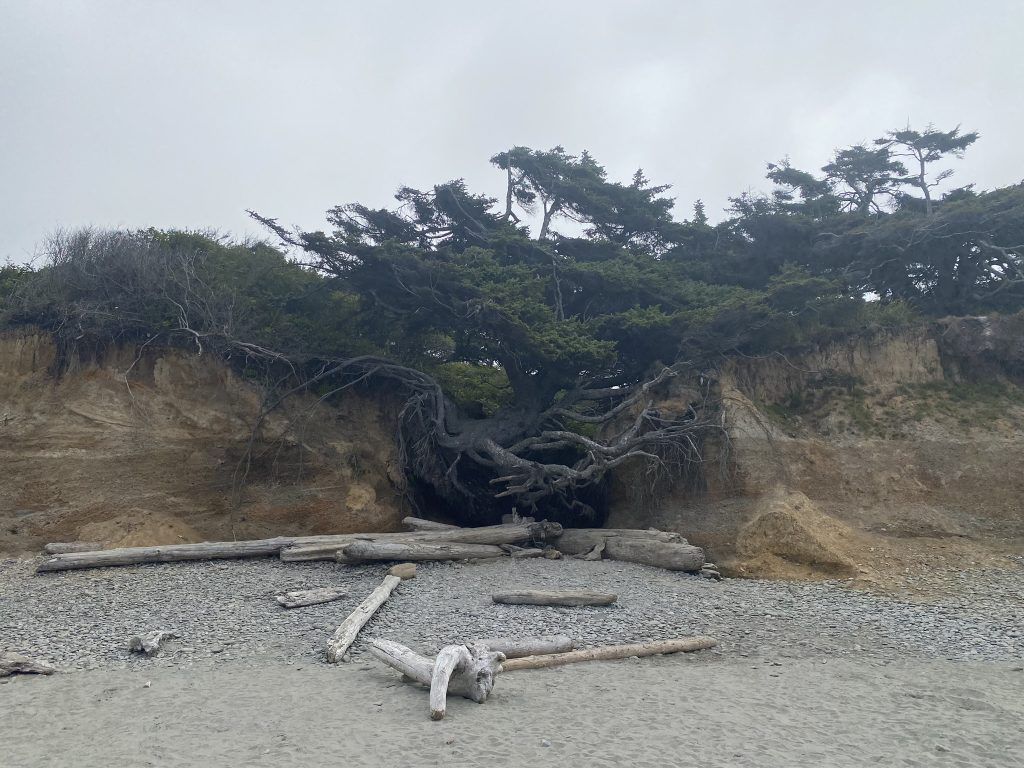
Kalaloch and Quinault
Continuing south, Kalaloch Beach features the famous “Tree of Life,” a Sitka spruce somehow surviving despite having its roots exposed by erosion. To find this unique natural wonder, park in the day-use area and follow the short, easy path and stairs down to the beach. A short walk to the right leads to the tree, which clings precariously between two cliffs.
Before reaching Aberdeen, the Quinault Rain Forest provides another opportunity to experience a temperate rainforest with fewer crowds than the Hoh. The 31-mile Quinault Loop Drive circles Lake Quinault, with short trails and roadside waterfalls perfect for quick exploration stops.
Option 2 – Ocean Shores
After leaving the Quinault Rain Forest, instead of heading to Aberdeen, visit the fun coastal town of Ocean Shores. Families can enjoy driving on the wide sandy beach, flying kites, or simply playing in the surf. It’s a great way to wrap up the trip with a relaxed beach day before heading home. As we drove through town, my husband noted that we had been here before, something I had completely forgotten. It had been many years ago, back when our kids were much younger and we visited with my parents. Coming back now felt like reconnecting with a sweet family memory, as my parents are no longer with us.
Family-Friendly Accommodations
After a long day exploring beaches and rainforests, find a hotel in Aberdeen to recharge.
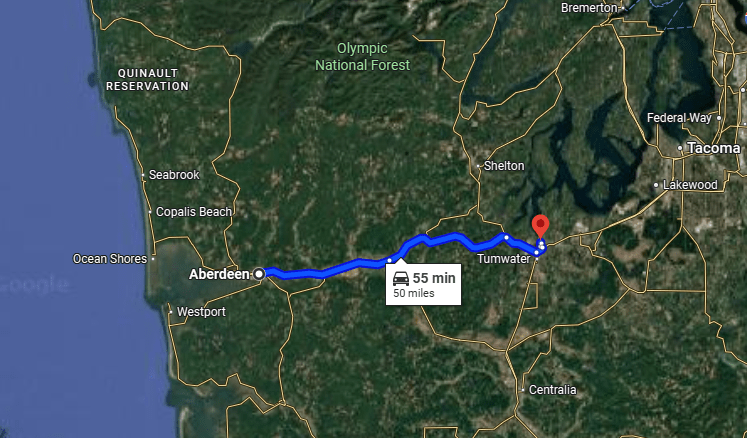
Section 5: Aberdeen to Kamilche/Olympia
Completing the Loop
As your Olympic Peninsula road trip winds down, this final leg offers a slower pace and a good chance to reflect on your family’s favorite moments. While it may be tempting to power through these last 50+ miles, there are still worthwhile stops along the way that help round out your adventure, especially for kids who aren’t quite ready to leave the coast behind.
- Aberdeen: Known as the birthplace of Kurt Cobain, Aberdeen has a gritty, working-class feel and a few surprises for curious travelers. Music-lovers might enjoy a quick stop at the Kurt Cobain Under the Bridge Memorial or a visit to the Aberdeen Museum of History, which features exhibits on logging, fishing, and the region’s history.
- Westport: Just 30 minutes off the route, Westport offers a breezy detour with ocean views, a working marina, and the Westport Maritime Museum. Families can climb the Grays Harbor Lighthouse (the tallest in Washington) or let kids run the wide beach before hopping back in the car.
- Aberdeen Science Center: This hands-on museum is perfect for curious kids with interactive exhibits covering physics, engineering, marine life, and more. It’s a great rainy-day stop where families can learn through play and explore science
- Codona’s Amusement Park: A classic family fun center, Codona’s offers mini golf, go-karts, bumper boats, and arcade games. It’s a lively stop to let kids burn off energy before the final leg of your road trip.
- Final stretch through forest and farmland: As Highway 101 curves back toward Kamilche and Olympia, you’ll pass through quiet timber country, farm stands, and peaceful valleys. This is a good time to swap stories, snack, or pull off for one last leg-stretching break before wrapping up your loop.
While this section doesn’t have as many national park landmarks, it offers a gentle close to your Olympic adventure. By the time you reach Olympia, chances are you’ll already be talking about which part of the peninsula you’d like to return to next.
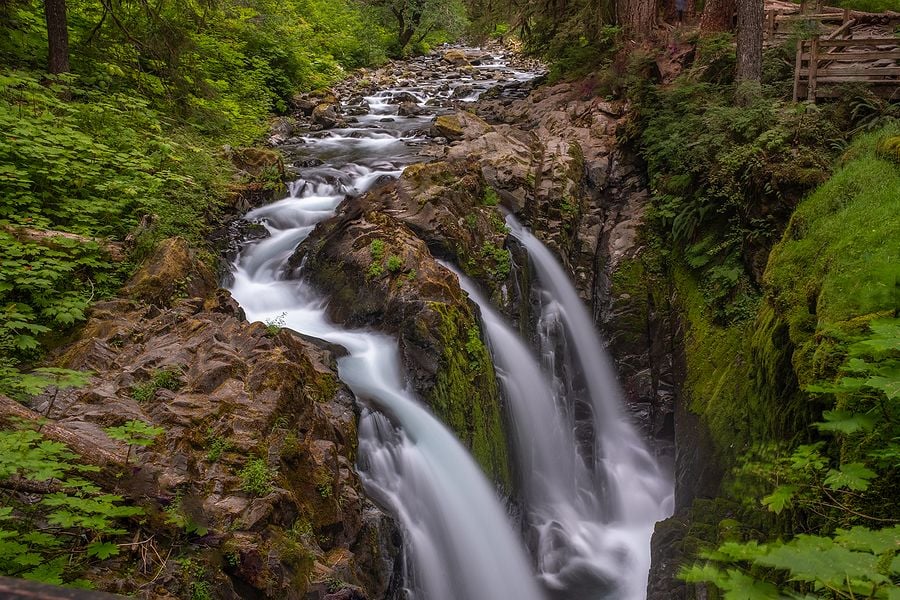
8-Day Olympic Peninsula Itinerary with Kids
While this sample itinerary offers a strong starting point, families may want to add or swap stops based on kids’ interests, timing, and tide schedules. For a deeper look at each region of Olympic National Park, including 10 detailed sections with family-friendly tips, be sure to explore our complete Olympic National Park guide for big families. It’s the perfect resource for tailoring your trip to your crew’s pace and priorities.
- Day 1: Start in Olympia (Washington’s capital), visit the Hands On Children’s Museum or Capitol Building, then drive north with stops at Staircase in Olympic National Park or a picnic at Potlatch State Park. Arrive in Port Townsend by evening.
- Day 2: Explore Port Townsend, including Fort Worden Historical State Park, the Marine Science Center, and downtown shops. Then enjoy an optional sunset stroll along the waterfront.
- Day 3: Depart Port Townsend; stop at Chimacum Valley farm stands and explore Sequim’s lavender farms. Spend time at Dungeness Spit before arriving in Port Angeles.
- Day 4: Spend the day in Olympic National Park’s alpine region: Hurricane Ridge in the morning, Lake Crescent and Marymere Falls in the afternoon. Finish the day at Sol Duc Hot Springs.
- Day 5: Head west on Highway 112 (Scenic Byway) to Neah Bay. Hike Cape Flattery Trail, explore the Makah Museum, and enjoy a quiet coastal evening or overnight in Forks.
- Day 6: Morning tidepooling at Rialto Beach or Second Beach (plan around low tide), then explore the Hoh Rain Forest in the late afternoon to avoid crowds. Spend the night in Forks or Kalaloch.
- Day 7: Visit Ruby Beach in the morning; explore Kalaloch’s Tree of Life and drive the Lake Quinault loop with short hikes and waterfall stops. Book a hotel near Quinault or Aberdeen.
- Day 8: Visit the Aberdeen Museum or detour to Westport for lighthouse climbing and ocean views. Return to Olympia via the final stretch of Highway 101.
You can easily modify this schedule depending on your starting and ending points, available time, and family’s travel style. For example, you could focus on your top picks, like regions 4, 3, and 2, traveling from the coastal south through tidepool beaches and rainforests, then finishing in the mountains near Port Angeles.
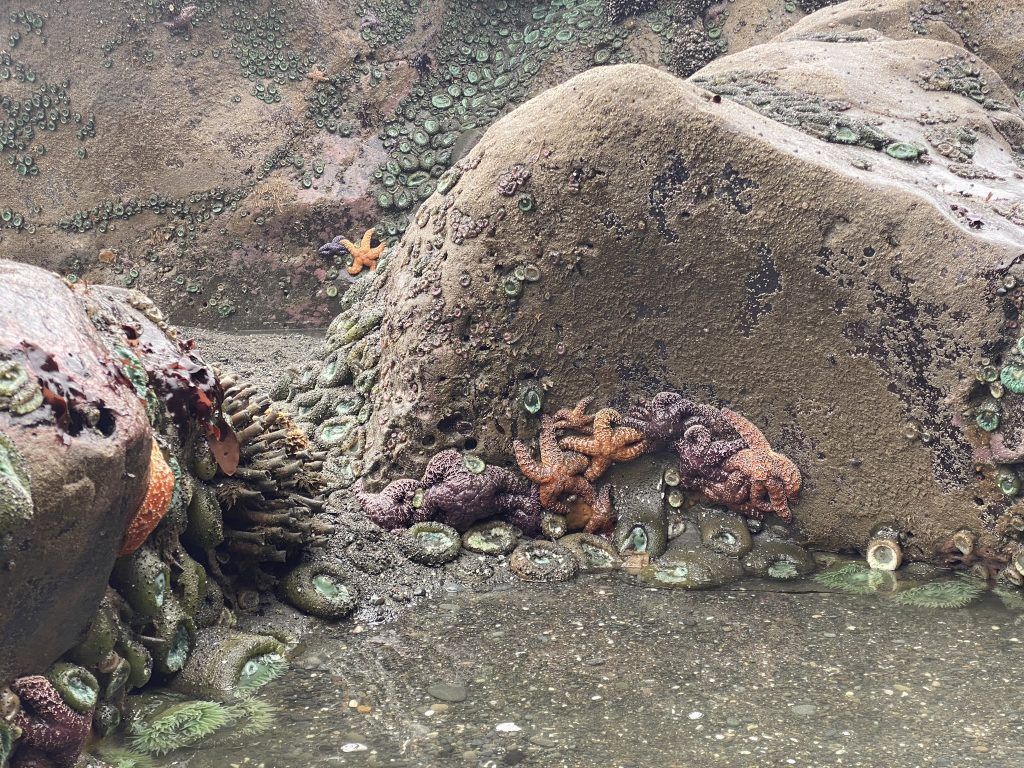
10 Essential Tips for Families Traveling the Olympic Peninsula
- Plan Around Tides – Tidepooling is one of the top kid-friendly activities along the coast, but it only works if you time it right. Use a free tide chart app like Tides Near Me to track daily lows and highs. If possible, plan your beach days around the lowest tides and build the rest of your itinerary from there.
- Expect Crowds in Popular Areas – Hoh Rain Forest and Hurricane Ridge can see long entrance lines in summer, especially between 10 a.m. and 3 p.m. Arrive early or late in the day to avoid wait times, or consider weekday visits. Parking is limited at trailheads, so always have a backup hike in mind.
- Know the Weather – Weather shifts fast here; you might need sunscreen, rain jackets, and sweatshirts all in the same afternoon. Pack layers, and keep towels, dry socks, and a change of clothes in the car. Trails can be muddy, even in July, so waterproof shoes help a lot.
- Watch for Limited Cell Service – Much of the loop has poor or no signal, especially inside Olympic National Park and along Highway 112. Download offline Google Maps, save directions ahead of time, and print any reservation details. It’s a good idea to set meeting spots just in case your family gets separated.
- Respect Tribal Lands – Parts of the loop pass through Native American reservations, including Makah land near Neah Bay. You’ll need to purchase a recreation pass to access places like Cape Flattery and Shi Shi Beach.
- Ferry Travel Tip – If you’re beginning your loop from Seattle, you can reach Port Townsend via ferry. Routes like Seattle to Bainbridge Island or Edmonds to Kingston connect to Highway 104 and Highway 101. Reservations are recommended during peak season, and boarding early helps avoid long waits with kids.
- Save with a National Parks Pass – Entry to Olympic National Park requires a pass, which can be purchased at entrance stations or online. If your family plans to visit more than one national park this year, consider the America the Beautiful annual pass. It covers entry fees for all U.S. national parks and is a smart deal for road-tripping families.
- Counter-clockwise Travel – While you can traverse the route in either direction, we found a counter-clockwise trip was best for passenger views.
- Be Flexible – Rain and overcast skies can dampen a visit to Hurricane Ridge. For the best views, schedule a couple of days in the area to increase your chances of clear skies.
- Know Your Daylight Hours – Plan your day with your known hours of daylight and schedule great sunsets along the coast.
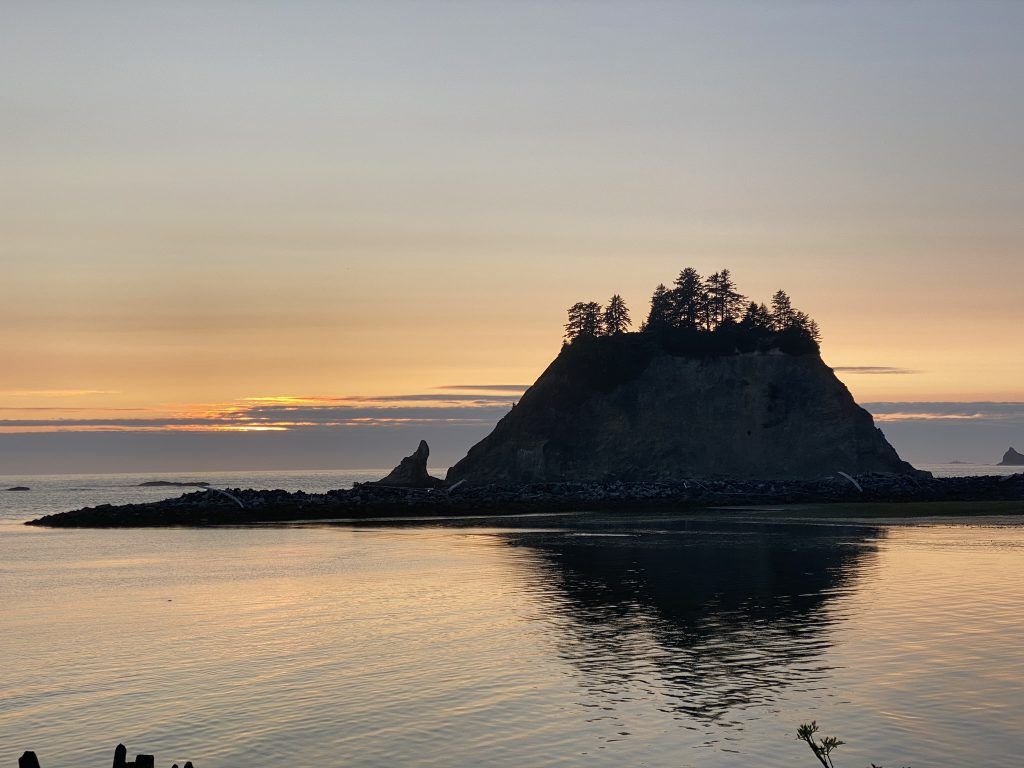
Traveling the Olympic Peninsula with kids is less about checking off bucket-list stops and more about slowing down, wandering through rainforests, skipping rocks on glacier-fed lakes, and listening to the ocean crash against sea stacks. This loop delivers all that and more in one trip.
While some parts of the route require extra patience (like narrow roads, wait times, or unpredictable weather), families who plan will be rewarded with a great experience. From the misty trails of the Hoh to the lavender fields of Sequim, every stop offers something new to discover.
The Olympic Peninsula loop is a classic Pacific Northwest road trip for a reason. If you’re unsure where to start, follow this itinerary as a framework and adjust based on your family’s needs, energy, and timing. Our complete Olympic National Park guide can help you dive deeper into each area. And when you’re ready to book, check out our lodging guides for hotels that sleep 6+.
